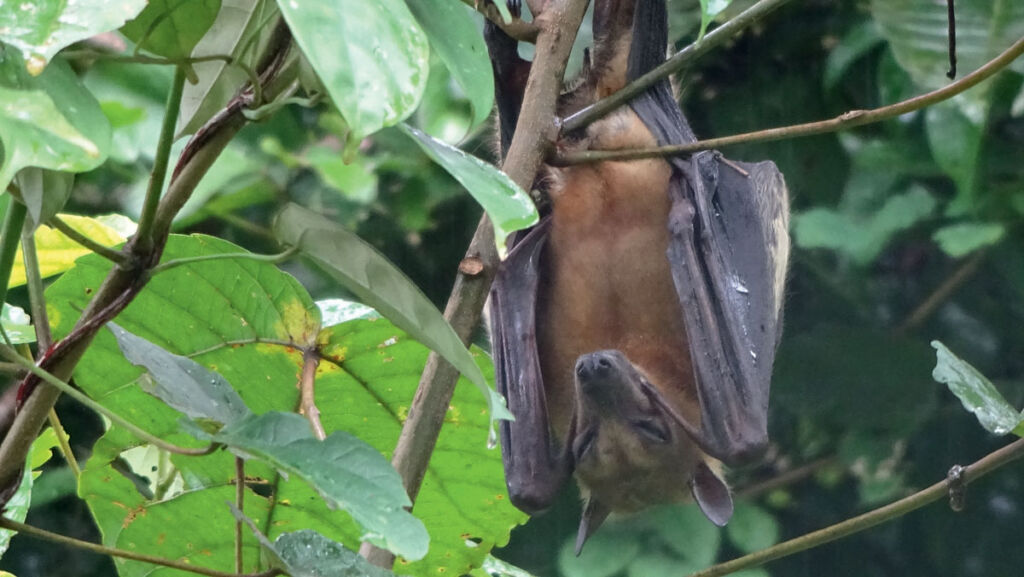[LUM#13] The bat under the radar
Gaining a better understanding of coronaviruses present in bats in order to better prevent, anticipate, and respond to a possible new zoonosis. This is the goal of the project led by virologist Martine Peeters. Explanations.

What do COVID-19, rabies, and Ebola have in common? "For each of these diseases, the natural reservoir of the virus is bats, " explains Martine Peeters. "When we trace the origins of an emerging infectious disease, we very often come across this small mammal, " says the virologist from the Translational Research on HIV and Infectious Diseases Laboratory*. But why bats? "They represent 20% of the world's mammals, so when we look for the origin of a zoonosis, there's a one in five chance that it will be bats, " explains the researcher.
Flying viral reservoirs
Found on every continent except Antarctica, these myriad bats are veritable flying viral reservoirs. Thousands of viruses have been identified in bats, in 28 distinct viral families. Including the coronavirus family. "Most of the time, infection with these viruses is asymptomatic in bats, so the animal will not die from the disease and can therefore spread the virus more effectively," explains Martine Peeters. And, as the only flying mammal, bats can move quickly and over long distances. "This means there is a greater risk that they will transmit the viruses they carry to other species." Including humans.
"In the coronavirus family alone, seven viruses have already been identified that have jumped from bats to humans." While four cause simple colds, the other three are responsible for Middle East Respiratory Syndrome (MERS-CoV) and severe acute respiratory syndromes caused by SARS-CoV-1 and SARS-CoV-2, the notorious coronavirus responsible for the COVID-19 pandemic. How did these viruses make the leap from bats to humans? "This cross-species transmission can occur via an intermediate host or directly, " replies Martine Peeters. Contact between humans and bats is very frequent: "Bats are hunted for food or to make traditional medicines, children play with these animals, their guano is used for crops, the fruit consumed by humans is sometimes contaminated by bat saliva, urine, or feces," explains the virologist. And the destruction of bats' natural habitat only increases the risk of inter-species transmission (read the article "If we don't change, it will happen again").
10,000 bats
This list of seven coronaviruses that have already spread to humans is therefore likely to grow in the near future. "To anticipate this possibility, it is important to gain a better understanding of the diversity of coronaviruses circulating in bats, " explains Martine Peeters. Accompanied by Guinean researcher Alpha Keita, the virologist aims to document the prevalence, genetic diversity, and geographical distribution of coronaviruses in wild bats in Africa. The goal is to assess the risk of future zoonotic transmission.
Researchers already have blood, saliva, and fecal samples collected in Guinea, Cameroon, and the Democratic Republic of Congo from more than 10,000 bats. Thanks to this new project, they will be able to screen these samples to study the presence of viral RNA or antibodies against coronaviruses and thus estimate their prevalence. Another objective is to study the seasonality of these viruses. "If certain coronaviruses have a seasonal expression, we may not find them in one-off samples. But we have been monitoring them monthly for a year, so we will be able to check for the presence of viruses in each sample and determine their possible seasonality."
Reduce the risk of transmission
This is valuable information for researchers: "In the case of seasonality, we will be able to identify the times when viral excretion is highest and thus determine the period of greatest risk of zoonotic transmission, " explains the virologist. This more detailed knowledge of coronaviruses present in bats would thus make it possible to reduce the risk of transmission, but also to identify the causative agent more quickly in the event of a new zoonosis , "particularly thanks to targeted diagnostic tools." And if this epidemic scenario were to recur, the results of this unprecedented project would offer hope for the faster development of a treatment or vaccine. "For example, we could work on developing a broad-spectrum vaccine. We would also have a better understanding of the targets for antiviral drugs that are potentially effective against these coronaviruses, in order to identify or develop effective treatments."
However , these are tools that everyone hopes they will never need. "The key to limiting the risk of new zoonoses is still to limit contact between humans and wildlife." Stay at home , and coronaviruses will stay where they belong.
Find UM podcasts now available on your favorite platform (Spotify, Deezer, Apple Podcasts, Amazon Music, etc.).
* TransVIHMI Joint Research Unit (UM, IRD, INSERM U1175, Cheikh Anta Diop University (Dakar, Senegal), Yaoundé 1 University (Cameroon))